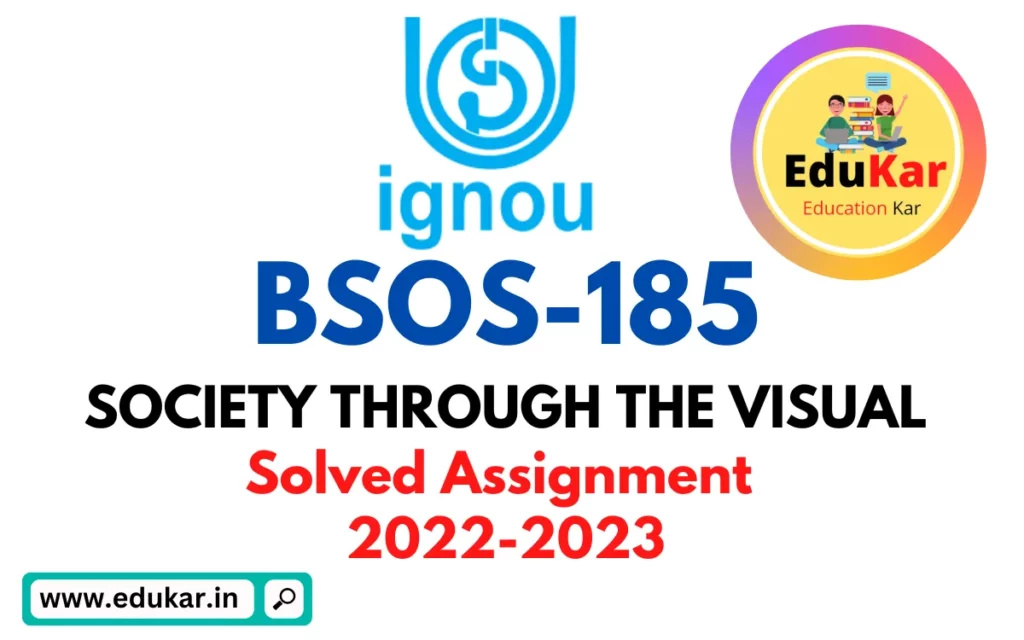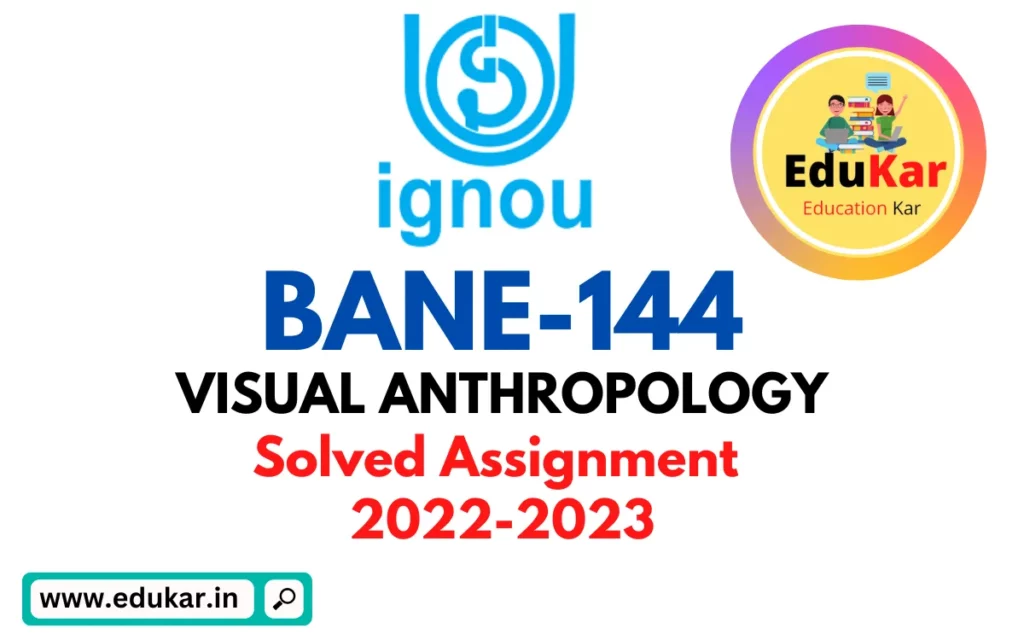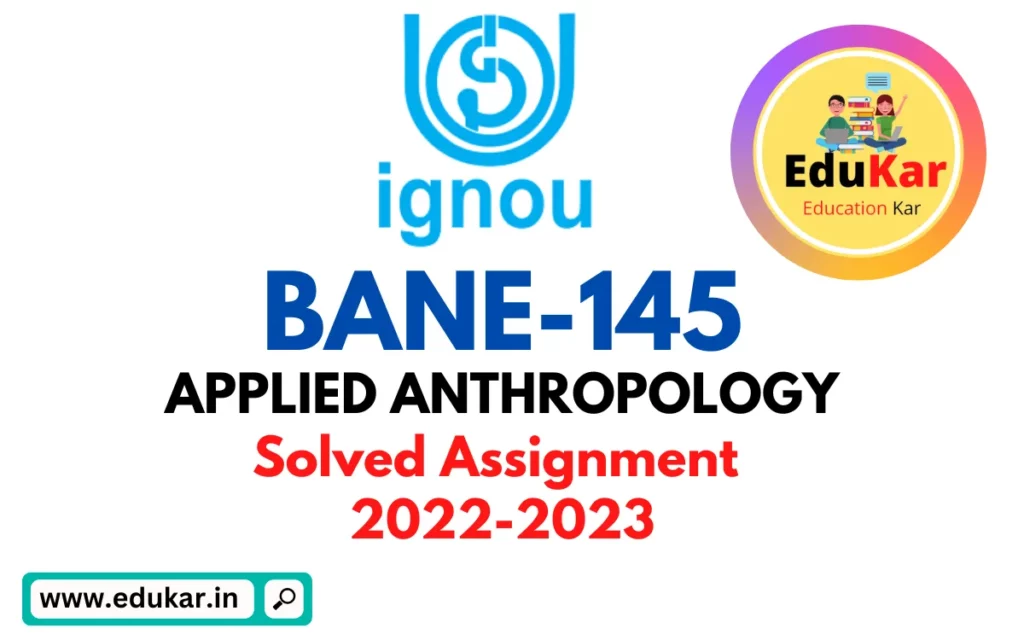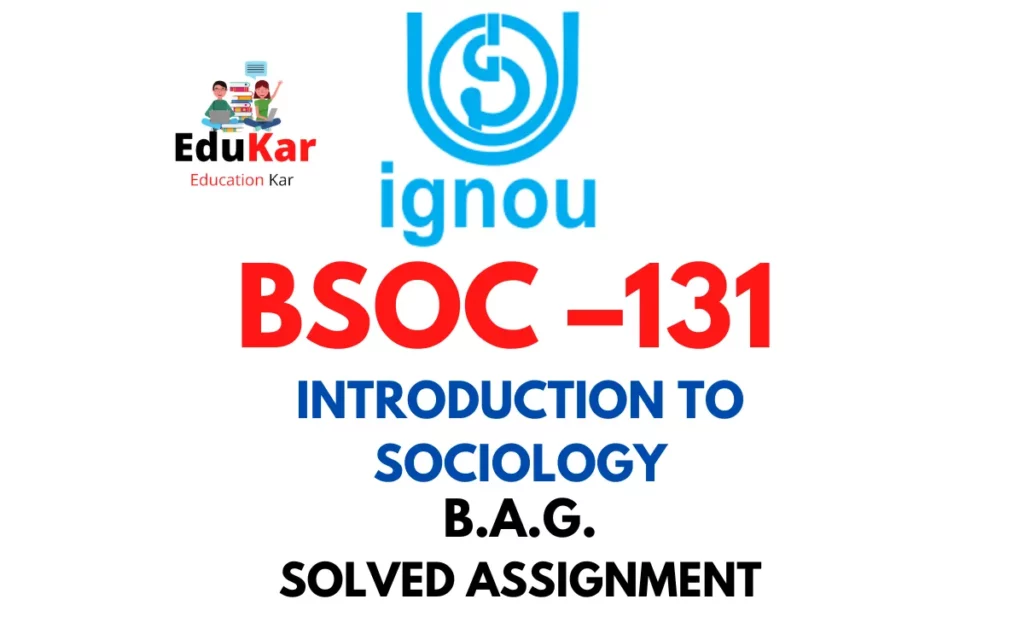Contents
- 1 Assignment A
- 2 Answer the following in about 500 words each.
- 3 1.Write an essay on Margaret Mead’s contribution to visual anthropology.
- 4 2.Discuss the nature of Participatory Documentary.
- 5 Assignment B
- 6 Answer the following questions in about 250 words each.
- 7 3.What are the ethical challenges to documentary film makers?
- 8 4. What do you understand by the term ‘male gaze’? Give suitable examples.
- 9 5. What is Culture Industry?
- 10 Assignment C
- 11 Write a note on the following in about 100 words each.
- 12 6. Cinema – verite
- 13 7. Thick and Thin description
- 14 8. Oral history
- 15 9. Dynamic shot
- 16 10. Camera movement

| Title | IGNOU-BSOS 184 Solved Assignment 2022-2023 (TECHNIQUES OF ETHNOGRAPHIC FILM MAKING) |
| University | IGNOU |
| Degree | Bachelor Degree Programme |
| Course Code | BSOS 184 |
| Course Name | TECHNIQUES OF ETHNOGRAPHIC FILM MAKING |
| Programme Name | Bachelor of Arts (General) |
| Programme Code | BAG |
| Total Marks | 100 |
| Year | 2022-2023 |
| Language | English |
| Assignment Code | ASST /TMA / July 2022-January 2023 |
| Last Date for Submission of Assignment: | For June Examination: 31st March For December Examination: 30th September |
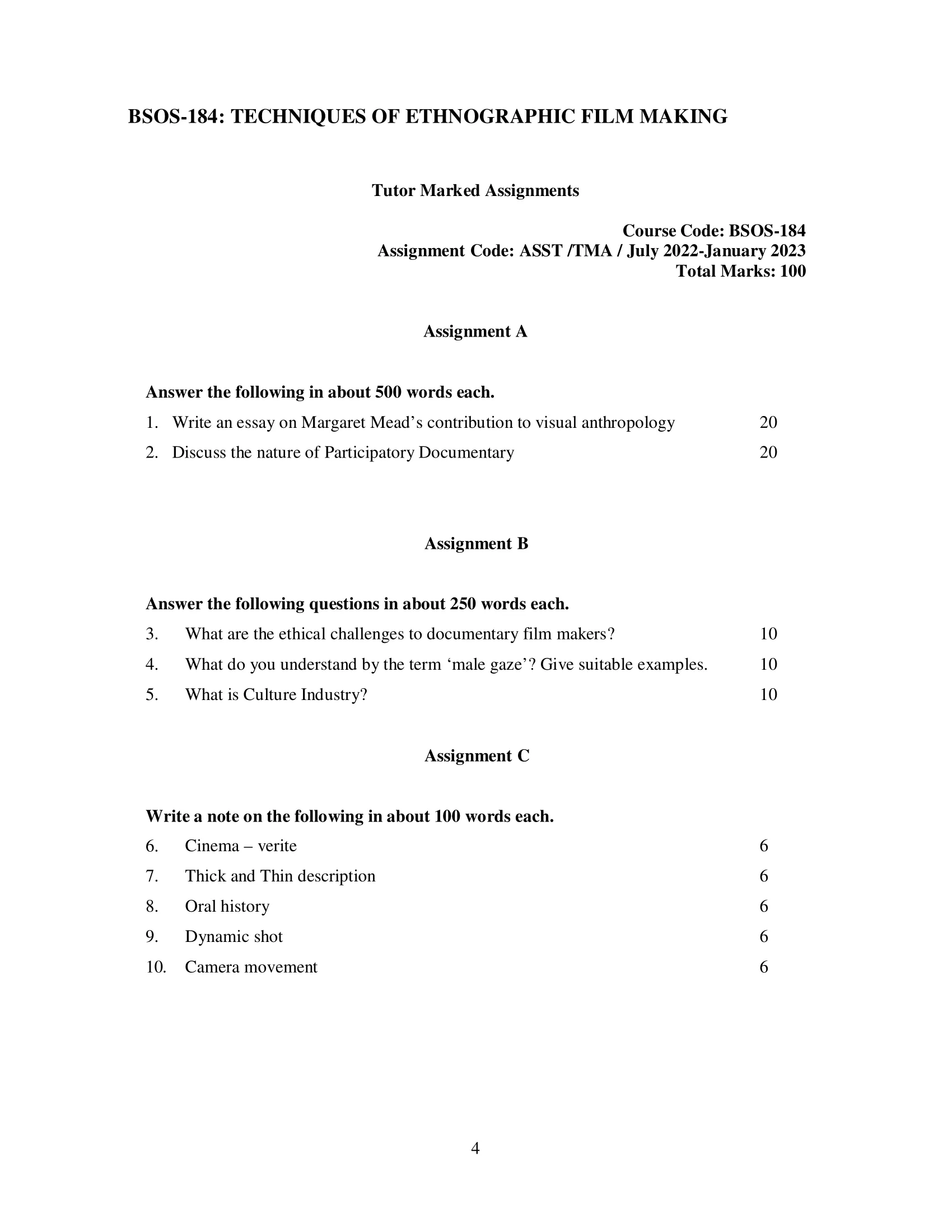
Assignment A
Answer the following in about 500 words each.
1.Write an essay on Margaret Mead’s contribution to visual anthropology.
Ans: Margaret Mead was an American cultural anthropologist who made significant contributions to the field of visual anthropology. She was born in 1901 and died in 1978. During her lifetime, she conducted extensive fieldwork in the Pacific and became a prominent figure in the field of cultural anthropology. In addition to her groundbreaking work in the field of anthropology, Mead was also a pioneering figure in the study of visual anthropology.
Visual anthropology is the study of visual forms of communication and expression, such as photography, film, and art. Mead was one of the first anthropologists to recognize the importance of visual media in understanding cultural patterns and beliefs. She believed that visual media could provide valuable insights into the cultural practices and beliefs of different societies, and she made extensive use of photography and film in her own fieldwork.
One of Mead’s most significant contributions to visual anthropology was her use of photography as a research tool. She believed that photographs could capture the essence of a cultural practice or belief in a way that words alone could not. She also believed that photographs could be used to help people understand the lives of people from different cultures, and she used this approach extensively in her fieldwork. For example, in her work among the people of Samoa, she took hundreds of photographs that documented the lives of the Samoan people, including their daily routines, beliefs, and rituals.
In addition to her use of photography, Mead was also an early adopter of film in the field of anthropology. She used film as a tool to capture the complex cultural practices and beliefs of different societies. In her work in Bali, for example, she used film to document the intricate dance performances that are an important part of Balinese culture. She believed that film could help to capture the essence of these cultural practices and provide valuable insights into the beliefs and values of the Balinese people.
Another important contribution that Mead made to visual anthropology was her focus on the role of visual media in shaping cultural beliefs and practices. She believed that visual media could play a significant role in shaping cultural beliefs and attitudes, and she used her work in the Pacific to demonstrate this. For example, she argued that the use of photography by Western colonial powers had helped to shape the beliefs and attitudes of the people they colonized, and that these beliefs and attitudes were then perpetuated through the use of visual media.
2.Discuss the nature of Participatory Documentary.
Ans: Participatory documentary is a type of documentary film that involves the active involvement of the subjects or participants in the filmmaking process. It is a collaborative approach that seeks to give a voice to the marginalized or underrepresented communities, and to create a space where they can tell their own stories in their own words. Participatory documentaries aim to create a dialogue between the filmmaker and the participants, with the goal of empowering the participants and giving them agency over the representation of their lives and experiences.
The key characteristic of participatory documentary is that it is a collaborative process between the filmmaker and the participants. The filmmaker is not just an observer, but an active collaborator who works with the participants to create the film. This collaboration can take many forms, from co-creating the film’s narrative to co-directing the film. The goal of participatory documentary is to empower the participants by giving them a say in the representation of their lives, and by allowing them to tell their own stories.
Another important aspect of participatory documentary is that it is often concerned with social justice issues. Many participatory documentaries focus on marginalized communities and seek to give voice to those who are often excluded from mainstream media. This can include communities that are facing economic, political, or cultural oppression, or those that are simply underrepresented in mainstream media. The goal of these documentaries is not only to shed light on these issues, but to give the participants a platform to share their perspectives and experiences.
One of the key benefits of participatory documentary is that it allows for a more authentic representation of the experiences and perspectives of the participants. Traditional documentaries are often made by outsiders who are looking in, and who may not fully understand the perspectives of the people they are filming. Participatory documentaries, on the other hand, are made in collaboration with the participants, and as a result, they often provide a more nuanced and complete representation of the experiences of the participants.
Another benefit of participatory documentary is that it can be a powerful tool for social change. By giving voice to marginalized communities, participatory documentaries can help to raise awareness of important social issues and inspire others to take action. For example, a participatory documentary about the experiences of refugees might not only shed light on the challenges faced by these communities, but it might also inspire others to take action to support them.
Assignment B
Answer the following questions in about 250 words each.
3.What are the ethical challenges to documentary film makers?
Ans: Documentary filmmakers face various ethical challenges as they strive to tell the truth and captivate their audience. Here are some of the major ethical challenges that documentary filmmakers face:
- Balancing truth and bias: The goal of documentary filmmaking is to present facts and events accurately, but the filmmaker’s personal opinions and biases can sometimes interfere with that objective. Documentary filmmakers must be aware of their own biases and work to present a balanced and fair view of their subject.
- Protecting subjects’ privacy: Filmmakers have a responsibility to protect the privacy and confidentiality of their subjects. This is especially important when filming sensitive or controversial subjects.
- Manipulating footage: The use of editing techniques and other visual effects can create an illusion of events that may not have actually occurred. Documentary filmmakers must avoid distorting the truth by manipulating footage.
- Dealing with consent: It’s important for documentary filmmakers to get the consent of their subjects before filming. This includes informed consent, where the subjects are fully aware of what is being filmed and how the footage will be used.
- Maintaining objectivity: Documentary filmmakers must avoid becoming too involved in their subject matter, as this can compromise their objectivity. This can be difficult, especially when dealing with emotional or controversial subjects.
- Ethical considerations of funding: Documentary filmmakers often rely on funding from outside sources, which can create ethical dilemmas if the funding comes from organizations with a vested interest in the subject matter.
4. What do you understand by the term ‘male gaze’? Give suitable examples.
Ans: The term “male gaze” was first introduced by feminist film critic Laura Mulvey in her seminal essay “Visual Pleasure and Narrative Cinema” (1975). It refers to the way in which the visual representation of women in film and media is typically seen through a heterosexual male perspective, often emphasizing the sexualization and objectification of women.
In the male gaze, women are portrayed as passive objects of desire, rather than as active, complex, and multi-dimensional characters. This representation of women reinforces patriarchal power structures and reinforces harmful gender stereotypes.
Examples of the male gaze can be seen in many popular films and television shows. In action movies, female characters are often reduced to eye candy, wearing revealing outfits and serving as the object of male desire. Similarly, in music videos, women are often shown in sexualized and objectifying positions, performing for the male gaze.
In advertising, the male gaze is evident in the way women’s bodies are often sexualized and objectified to sell products, from fashion to beauty to technology. Even in news and current events programming, the male gaze can be seen in the way women are often framed, with camera angles and editing emphasizing their appearance rather than their words or accomplishments.
The male gaze is harmful not only to women, but also to men, as it reinforces toxic masculinity and reinforces the idea that men should view women as objects of desire. It also perpetuates a culture that devalues women and reinforces patriarchal power structures.
It is important for filmmakers, media creators, and consumers to be aware of the male gaze and to actively work to challenge and dismantle it. This can include creating and promoting media that represents women in complex and multi-dimensional ways, and calling out harmful depictions of women in media. By working to create a more equitable and respectful representation of women in media, we can create a more just and equitable world.
5. What is Culture Industry?
Ans: The term “culture industry” was introduced by the Frankfurt School philosophers, Max Horkheimer and Theodor Adorno, in their book “Dialectic of Enlightenment” (1944). The culture industry refers to the commodification and mass production of cultural products, such as music, films, books, and art, which are designed to meet the demands of the consumer market.
In the culture industry, cultural products are no longer seen as individual expressions of creativity and originality, but instead as commodities that are mass-produced and standardized to appeal to the largest possible audience. This standardization leads to a homogenization of culture, where cultural products are reduced to a lowest common denominator and lose their individuality and unique qualities.
The culture industry has a profound impact on society and its values. By presenting standardized and homogenized cultural products, it reinforces dominant ideologies and reinforces the status quo, rather than encouraging critical thinking and cultural diversity. It also reinforces consumerism, as people are encouraged to consume cultural products as a means of expressing their identity and status.
Furthermore, the culture industry has a negative impact on the creative industries, as it often leads to a commodification and commercialization of art and creativity. Artists are pressured to conform to market demands, leading to a loss of creativity and originality.
The culture industry also reinforces inequalities, as it often perpetuates negative stereotypes and reinforces dominant power structures, such as patriarchy and racism.
Assignment C
Write a note on the following in about 100 words each.
6. Cinema – verite
Ans: Cinema verité, meaning “truthful cinema” in French, is a documentary film style that emphasizes a naturalistic and unscripted approach to filmmaking. It is characterized by the use of hand-held cameras, unobtrusive camera placement, and a focus on capturing real-life events as they unfold, without the use of extensive scripting or re-enactments. The goal of cinema verité is to present a truthful representation of reality, often exposing social issues or capturing significant events in history. Notable filmmakers in the cinema verité tradition include D.A. Pennebaker, Frederick Wiseman, and the Maysles brothers. Despite its roots in the 1960s, cinema verité continues to be a popular and influential approach in contemporary documentary filmmaking.
7. Thick and Thin description
Ans: Thick and thin description are terms used to describe different approaches to observing and describing human behavior. Thick description refers to a rich and detailed account of human behavior, including its cultural and historical context, the motivations of the individuals involved, and the effects of their actions on others. It provides a nuanced and in-depth understanding of a particular situation or event.
On the other hand, thin description provides a minimal and objective account of behavior, focusing only on observable actions and disregarding the context, motivations, and cultural influences that shape them. Thin description is often used in natural sciences, where the goal is to identify universal laws and patterns in behavior, rather than to understand the unique and complex experiences of individuals.
In anthropology, thick description is considered the more desirable approach, as it provides a more nuanced and complete understanding of human behavior. However, both thick and thin description have their place in different academic fields and research methodologies, and the appropriate level of description depends on the research question and the goals of the study.
8. Oral history
Ans: Oral history is a method of collecting historical information through recorded interviews with individuals who have lived through significant events or experiences. It is a form of qualitative research that emphasizes the personal perspectives, memories, and emotions of the interviewees, rather than solely relying on written records or official accounts.
Oral history has been used to gather information about a wide range of subjects, including social, cultural, political, and economic histories. The recorded interviews are transcribed and analyzed to gain insight into historical events and the experiences of individuals and communities. Oral history can also provide a platform for marginalized or underrepresented groups to share their stories and perspectives, which may otherwise go unrecorded.
The methodology of oral history involves the use of open-ended questions and a focus on the interviewee’s perspective, allowing them to tell their story in their own words. The result is a rich and personal account of historical events and experiences that can complement and enrich traditional historical research.
9. Dynamic shot
Ans: A dynamic shot is a type of shot in film and video production that creates a sense of movement and energy. Dynamic shots are often used to add visual interest to a scene and to keep the audience engaged. Some common examples of dynamic shots include tracking shots, crane shots, and handheld shots. Tracking shots follow the movement of the subject, crane shots involve a sweeping movement of the camera, and handheld shots are shot while holding the camera, creating a more intimate and raw feel. Dynamic shots can convey a sense of motion and excitement and are often used in action sequences or to add a sense of immediacy to a scene. By using dynamic shots, filmmakers can bring their scenes to life and create a more engaging and visually dynamic film or video.
10. Camera movement
Ans: Camera movement refers to the physical movement of the camera during the filming of a scene. Camera movement can be used to create different visual effects and to control the audience’s attention. Some common types of camera movement include panning, tilting, zooming, and tracking. Panning refers to a horizontal movement of the camera, tilting refers to a vertical movement, zooming refers to a change in the focal length of the lens, and tracking refers to a movement of the camera parallel to the subject. Camera movement can be used to create visual interest, to convey a sense of motion or dynamic energy, and to control the audience’s attention. It is an important element in film and video production and can greatly impact the visual style and emotional impact of a scene.
How to Download BSOS 184 Solved Assignment?
You can download it from the www.edukar.in, they have a big database for all the IGNOU solved assignments.
Is the BSOS 184 Solved Assignment Free?
Yes this is absolutely free to download the solved assignment from www.edukar.in
What is the last submission date for BSOS 184 Assignment?
For June Examination: 31st March, For December Examination: 30th September

